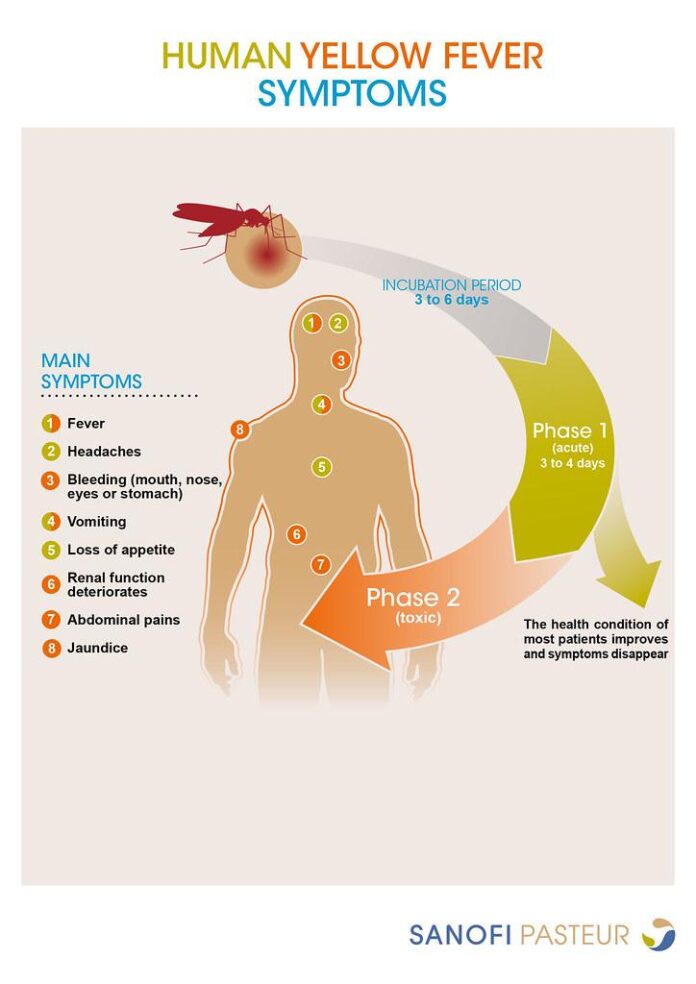
Yellow fever is a viral disease that is transmitted by mosquitoes and is endemic in tropical regions of Africa and South America. The virus can cause a wide range of symptoms, from mild to severe, and can be fatal in some cases. Understanding the symptoms of yellow fever is crucial in seeking prompt medical attention and treatment.
In this article, we will discuss the symptoms of yellow fever, its potential complications, and the importance of vaccination as a preventative measure. Recognizing the signs of infection can help individuals take necessary precautions and seek medical care if necessary.
1. Fever and Chills
The onset of yellow fever is typically marked by a sudden onset of fever and chills. Patients may experience high fever, which can reach up to 104°F, along with profuse sweating and chills. This fever can last for several days and may subside before returning, leading to a cyclical pattern of symptoms.
Other accompanying symptoms of fever and chills may include body aches, headache, and muscle pain. These flu-like symptoms are often initial indicators of yellow fever and should prompt individuals to seek medical evaluation.
2. Jaundice
One of the hallmark symptoms of yellow fever is jaundice, which is characterized by a yellowing of the skin and the whites of the eyes. This occurs due to liver damage caused by the virus, resulting in a buildup of bilirubin in the bloodstream.
Individuals with jaundice may also experience dark urine and pale stools, along with abdominal pain and tenderness in the liver area. Jaundice can indicate a more severe form of yellow fever and necessitates immediate medical attention.
3. Nausea and Vomiting
Nausea and vomiting are common symptoms of yellow fever, often accompanying the onset of fever and jaundice. Patients may experience persistent nausea and an aversion to food, along with episodes of vomiting.
Dehydration can occur as a result of these symptoms, especially in severe cases of yellow fever. Therefore, it is essential for individuals to stay hydrated and seek medical care if they are unable to tolerate oral fluids.
4. Bleeding and Hemorrhage
In severe cases of yellow fever, patients may develop bleeding and hemorrhagic symptoms. These can include bleeding from the gums, nosebleeds, and blood in the vomit or feces. Additionally, bruising and petechiae (tiny red or purple spots on the skin) may be present.
Bleeding and hemorrhage are signs of a more advanced stage of yellow fever and require immediate medical intervention. Patients may need supportive care to manage bleeding and to stabilize their condition.
5. Liver and Kidney Failure
Yellow fever can lead to liver and kidney failure, particularly in severe cases of the disease. This can manifest as abdominal pain, dark urine, decreased urine output, and jaundice as discussed earlier.
Individuals experiencing these symptoms should seek urgent medical care, as organ failure can be life-threatening and requires comprehensive medical management.
6. Heart and Central Nervous System Involvement
In some cases, yellow fever can affect the heart and central nervous system, leading to complications such as myocarditis (inflammation of the heart muscle) and encephalitis (inflammation of the brain). These complications can result in symptoms such as chest pain, palpitations, confusion, and seizures.
Patients with these manifestations of yellow fever should be promptly evaluated by healthcare professionals to initiate appropriate treatment and prevent further complications.
7. Inflammation of the Liver and Kidneys
Inflammation of the liver (hepatitis) and kidneys can occur in yellow fever, leading to symptoms such as abdominal pain, tenderness in the liver area, and changes in urine output and appearance.
Individuals experiencing these symptoms should seek medical evaluation to assess the extent of organ involvement and to receive appropriate medical care.
8. Photophobia and Eye Pain
Yellow fever can cause sensitivity to light (photophobia) and eye pain, indicating involvement of the eyes and potential complications such as uveitis. Patients may experience redness, pain, and visual disturbances, requiring assessment by ophthalmologists or healthcare professionals.
These symptoms may indicate a more severe form of yellow fever and necessitate comprehensive evaluation and treatment.
9. Dehydration and Weakness
Dehydration and weakness can accompany the flu-like symptoms of yellow fever, leading to fatigue, dizziness, and decreased tolerance for physical activity. These symptoms can be exacerbated by vomiting and decreased fluid intake, requiring supportive care to restore hydration and electrolyte balance.
Individuals experiencing dehydration and weakness should seek medical attention to prevent further complications and to receive appropriate management.
10. Confusion and Altered Mental Status
In severe cases of yellow fever, individuals may experience confusion, disorientation, and altered mental status, indicating potential involvement of the central nervous system. These neurological symptoms require immediate medical evaluation and may necessitate hospitalization for comprehensive care.
Patients with these symptoms should seek urgent medical attention to prevent further deterioration and to receive appropriate medical management.
In conclusion, recognizing the symptoms of yellow fever is essential for prompt diagnosis and medical intervention. Individuals living in or traveling to endemic regions should be aware of the signs of yellow fever and seek vaccination as a preventive measure. Additionally, practicing mosquito bite prevention strategies can reduce the risk of yellow fever transmission. By understanding the symptoms and taking preventive measures, individuals can protect themselves from the potentially serious effects of yellow fever.












